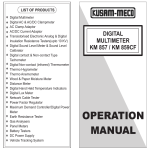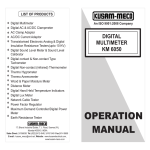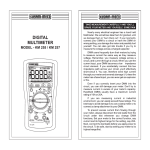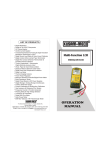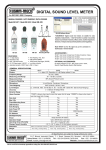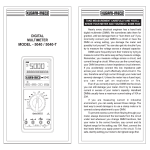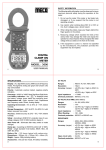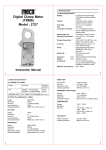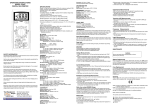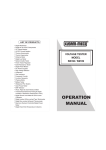Download 405 mannual (NEW) - Kusam Electrical Industries Ltd.
Transcript
DIGITAL MULTIMETER 405 TAKE MEASUREMENT CAREFULLY AND YOU’LL SPARE YOUR METER AND YOURSELF, SOME PAIN Nearly every electrical engineer has a hand held digital multimeter (DMM). We sometimes take them for granted, until we damage them or “burn them out” if you incorrectly connect your DMM to a circuit, or if you have the DMM on wrong setting, you damage the meter and possibly hurt yourself. You can also get into trouble if you try to measure the voltage across a charged capacitor. DMM users frequently burn their meters by trying to measure current the same way as they measure voltage, Remember, you measure voltage across a circuit, and current through a circuit. When you use the current input, your DMM becomes a lower impedance circuit element. If you accidentally connect this low impedance path across your circuit, you’ll effectively short-circuit it. You can, therefore send high current through your meter and severely damage it. Unless the meter has a fused input, you can even get an explosion or fire. Even if you correctly insert your DMM into the circuit, you can still damage your meter. Don’t try to measure current in excess of your meter’s capacity. Handheld DMMs usually have a maximum current rating of 10A or 20A. If you are measuring current in industrial environment, you can easily exceed those ratings. The best way to avoid damage is to use a clamp meter or to connect a clamp attachment to your DMM. To prevent excess current from flowing through your meter, always disconnect the test leads from the circuit under test whenever you change DMM functions, Set your meter to the correct function, say current and its highest range for the setting, say 10A. Next, connect the test leads before you apply power to the circuit. To be safe, start by setting your meter to its highest range first. Table of Contents Title Overview Unpacking Inspection Features General Specification Electrical Specification DC Voltage AC Voltage AC Current DC Current Resistance Frequency Duty Cycle Logic Test Continuity & Diode Test Page 1 2 3 4 5 Rules For Safe Operation International Electrical Symbols The Multimeter Structure Functional Buttons Display symbols 8 9 10 11 12 Measurement Operation A. DC Voltage Measurement B. AC Voltage Measurement C. AC Current Measurement D. DC Current Measurement E. Measuring Resistance F. Measuring Frequency G. Duty Cycle Measurement H. Logic Testing I. Diode Test & Continuity 13 13 15 16 18 19 21 23 23 24 Maintenance A. Replacing the Battery & fuse Test Certificate Warranty 26 26 27 29 Overview Unpacking Inspection ! Warning To avoid electric shock or personal injury, read the “Safety Information” and “Rules for Safe Operation”carefully before using the Meter. Digital Multimeter Model - 405 (hereafter referred to as “the Meter”) is a 4½ digits TRMS Multimeter with steady operations, and highly reliable hand-held measuring instrument having different measurement positions. The Multimeter not only can measure AC/DC Voltage, AC/DC Current, Resistance, Frequency, Diode Test, Logic Test, but also has Data Hold, Full Icon Display. Open the package case and take out the Multimeter. Check the following items carefully to see any missing or damaged part : Item Description Qty. 1 English Operating Manual 1 piece 2 Test Lead 1 pair In the event you find any Part missing or damaged, please contact your dealer immediately. Terms in this manual ! Warning : Identifies conditions and actions that could result in serious injury or even death to the user. Caution : Identifies conditions and actions that could cause damage or malfunction instrument. 1 2 GENERAL SPECIFICATIONS : FEATURES : Low power consumption CMOS double integration, A/D transform integrated circuit, Auto Zero Calibration, Auto Polarity display, Data Hold, Low Battery & Over range indication. n Display : 4½ digit (19999 Counts) with digit height 17mm and function/units sign annunciators. n Selected Range displayed on LCD. n High Accuracy - Digital Reading. n Display Digit Size : 17mm(H) Polarity : Automatic, (-) negative polarity indication. Overrange indication : ‘1’ most significant digit. Low Battery Indication : The “ - + ” sign is displayed when the battery voltage drops below the operating Voltage. Auto Power Off : Meter automatically shuts down after approx. 45.minutes of inactivity. Instant Continuity Buzzer. n Overload Protection in all Ranges. n Recessed Safety Designed Input Jacks. n “ DATA - HOLD ” switch freezes reading. n CE Approved, GS-approved. n IEC61010 overload category II n 3 : 4½ digit LCD. Maximum reading 19999 with Function and unit sign annunciators. Measurement rate : 2.5 times per Second, nominal Operating environment : 0°C to + 50°C, <70% R.H. Storage temperature : -20°C to 60°C, 0 to 80% RH with battery removed. Power : Single 9 V Battery. Power Consumption : 14mW Typical. Dimension : 189mm (H) X 87mm(W) X 37mm(D) Weight : Approx. (330 grams) including battery. Accessories : Test Leads, Carrying Case, User Manual, Battery, Tilt stand, Protective Holster 4 ELECTRICAL SPECIFICATION : DC VOLTAGE AC CURRENT (TRUE RMS) Range Resolution Accuracy 200 m A 10 nA nA 2 mA 100 ±(0.8% rdg + 10 dgts) m A 20 mA 1 m A 200 mA 10 ±(2.5% rdg + 10 dgts) 20 A* 1 mA Range Resolution Accuracy 10 m V 200 mV 100 m V 2 V 20 V 1 mV ±(0.05% rdg + 3dgts) 200 V 10 mV 1000 V 100 mV Input Impedance : 10MW Overload Protection : 500V DC/350Vrms on 200mV range, 1000V DC/750V rms on all other ranges Burden Voltage : 300mV for 200m A, 2mA, 20mA 600mV for 200mA & 800mV for 20A. Overload Protection : 500mA/600V fuse on mA inputs (fast blow ceramic fuse). * 20A/600V fuse on 20A inputs (fast blow ceramic fuse). 20A for 30 seconds maximum. AC VOLTAGE 50Hz~500Hz (TRUE RMS) DC CURRENT Range Resolution Accuracy m V 200 mV 10 V 2 V 100 m ±(1.0% rdg +10 dgts) 20 V 1 mV mV 200 V 10 ±(2.0% rdg + 20 dgts) 750 V 100 mV Input Impedance : 10MW Overload Protection : 500V DC or 350Vrms on 200mV range, 1000V DC or 750Vrms on all other range Range Resolution Accuracy 200 m A 10 nA 100 nA 2 mA ±(0.5% rdg + 5 dgts) 1 m A 20 mA 10 m A 200 mA 20 A* 1 mA ±(2.0% rdg + 10 dgts) Burden Voltage : 300mV for 200m A, 2mA, 20mA 600mV for 200mA & 800mV for 20A. Overload Protection : 500mA/600V fuse on mA inputs (fast blow ceramic fuse). * 20A/600V fuse on 20A inputs (fast blow ceramic fuse). 20A for 30 seconds maximum. AC VOLTAGE 500Hz to 2KHz (TRUE RMS) Range Resolution Accuracy m V 200 mV 10 V 2 V 100 m ±(2.0% rdg + 20 dgts) 20 V 1 mV 10 mV 200 V Unspecifled 750 V 100 mV Input Impedance : 10MW Overload Protection : 500V DC or 350Vrms on 200mV range 1000V DC or 750Vrms on all other range 5 RESISTANCE Range Resolution Accuracy ±(0.25% rdg + 10 dgts) 200 W 0.01 W 0.1 W 2 KW ±(0.15% rdg + 3 dgts) 20 KW 1 W 200KW 10 W ±(0.25% rdg + 10 dgts) 2 MW 100 W ±(1.0% rdg + 10 dgts) 20 MW 1 KW Overload Protection : 500V DC or AC rms Burden Voltage : 3.3V DC 6 FREQUENCY Range Rules For Safe Operation (1) Resolution Accuracy Input Imped. 2 KHz 0.1 Hz // 10pF 20 KHz 1 Hz ±(0.5% rdg+3dgts) 10MW 200KHz 10 Hz Sensitivity : 50mV rms (Sine Wave), 400mV rms at > 30% and < 70% duty cycle Input Frequency : More than 10 Hz at pulse width > 2m sec. Overload Protection : 500V DC or AC rms DUTY CYCLE Range Resol. Pulse Width Accuracy sec. ±(2.0% rdg +10dgts) 0 - 90.0% 0.1% > 10m Overload Protection : 500V DC or AC rms Frequency Range : 20 Hz to 20 KHz LOGIC TEST Threshold Pulse Rep Pulse Rise Pulse (max) Logic Hi Logic Low Width(min) (max) 1Mpps 10m sec 2.8V±0.8V 0.8V±0.5V 25ns Test Voltage : 5V DC Duty Cycle : >20% and <80% Indication : 40msec beep at logic Hi Overload Protection : 500V DC or AC rms Frequency Response : 20MHz CONTINUITY TEST Range 2V Open Circuit Response Audible Volts Time Indication Approx. 500ms 3.3V DC Typical Less than 150W Overload Protection : 500V DC or AC rms DIODE TEST Range Resol. 2V Accuracy 0.1mV ±(0.5% rdg + 1dgt) Test Open Circuit Current Volts 1.0mA 3.3V DC Typical Overload Protection : 500V DC or AC rms 7 ! Warning To avoid possible electric shock or personal injury, and to avoid possible damage to the Meter or to the equipment under test, adhere to the following rules : Before using the Meter inspect the case. Do not use the Meter if it is damaged or the case (or part of the case) is removed. Look for cracks or missing plastic. Pay attention to the insulation around the connectors. n Inspect the test leads for damaged insulation or exposed metal. Check the test leads for Continuity. Replace damaged test leads with identical electrical Specifications before using the Meter. n Do not apply more than the rated voltage, as marked on the Meter, between the terminals or between any terminal and grounding. n The rotary switch should be placed in the right position and no any changeover of range shall be made while measurement is conducted to prevent damage of the Meter. n When measurement is taken at an effective voltage over 60V in DC or 30V rms in AC, special care should be taken for there is danger of electric shock. n Use the proper terminals, function, and range for your measurements. n Do not use or store the Meter in an environment of high temperature, humidity, explosive, inflammable and strong magnetic field. The performance of the Meter may deteriorate after the meter is dampened. n When using the test leads, keep your fingers behind the finger guards. n 8 Rules For Safe Operation (2) Disconnect circuit power and discharge all high -voltage capacitors before testing resistance, continuity, diodes, or current. n Replace the battery as soon as the battery indicator - + appears. With a low battery, the Meter might produce false readings that can lead to electric shock and personal injury. n Turn the Meter power off when it is not in use and take out the battery when not using for a long time. n Constantly check the battery as it may leak when it has not been used for some time, replace the battery as soon as leaking appears. A leaking battery will damage the Meter. The Multimeter Structure (see figure 1) n LOGIC V 1 TUV SAFETY APPROVED TO IEC1010 2 DATA HOLD POWER AUTO POWER OFF TRUE RMS V 20 200 750 1000 200 V 20 2 2 200m 200m LOGIC 200m 2 20m 20A 200m A 2m 2m A 20m 20A 200m 200m 200k 4 20M 20k 2k DUTY% Hz 20A International Electrical Symbols 1.9999 DC 200 2k 20k m A mA 2M 200k COM W CAT. II VW Hz 3 20A MAX FUSED 200mA MAX FUSED 1000V 750V MAX 405 MULTIMETER AC (Alternating Current). ~ DC (Direct Current). Both DC & AC. ~ Grounding. Double Insulated. - + Deficiency of Built-In Battery. Continuity Test. Diode. Fuse. ! Warning ! Refer to the Operating Manual. Caution ! Risk of Electric Shock. ( Figure 1) 1) LCD DISPLAY : A 4½ digit display (maximum reading 19999) indicates measured values, and features symbols indicating function, Low Battery, Continuity, Diode, Logic. 2) FUNCTION SELECTOR : To Select ACV, DCV, ACA, DCA, Resistance, Frequency, Diode, Continuity & Logic Test. 3) INPUT JACKS (VW , mA , A and COM) : Test leads are inserted into these jacks for Voltage, Resistance, Current measurements, Continuity & Diode Checks. 4) PROTECTIVE HOLSTER : Prevents the instrument from damage. Logic test 9 10 Functional Buttons Display Symbols Below table indicates the functional button operations Buttons POWER (Black Button) DATA-HOLD (Black Button) ~ Operation Performed H Switch the Meter on and off. n Press the POWER button to switch on the Meter. n Press the POWER button to turn off the Meter. Press HOLD Button to hold the reading on the display. n Press HOLD button again to exit hold mode. (see figure 2) 1.9.9.9.9 ( Figure 2) n No. Symbol Meaning Dangerous Voltages. 1 The battery is low. ! Warning : To avoid false readings, which could lead to possible electric shock or personal injury, replace the battery as soon as the battery indicator appears. Indicator for AC voltage or current, The displayed value is the mean value. 2 - + 3 ~ Indicates negative reading. 4 Test of diode. 5 6 H Data Hold is active. The continuity buzzer is on. 7 8 A A : Amperes (amps). The unit of current. 9 V V : Volts. The unit of voltage. 10 Hz Hz : The unit of frequency. % % : The unit of Duty cycle. 11 12 W : Ohm. The unit of resistance. W , kW , 3 KW : kilohm. 1 x 10 ohms. MW 6 MW : Mega Ohm 1 x 10 ohms. 13 : The symbol of logic Hi : The symbol of logic Low 11 12 Measurement Operation Make sure the Low Battery display - + is not on, otherwise false readings may be provided. n Pay extra attention to the ! symbol which is located besides the input terminals of the Meter before carrying out measurement. n A) DC voltage measurement (see figure 3) The DC Voltage ranges are :200mV, 2V, 20V, 200V, 1000V. To measure DC voltage, connect the Meter as follows : 1) Insert the red test lead into the VW input terminal and the black test lead into the COM input terminal 2) Set the rotary switch to an appropriate measurement position in V range. 3) Connect the test leads across with the object being measured. LOGIC 1.9999 DC V ~ The measured value is shown on the display. TUV SAFETY APPROVED TO IEC1010 2 DATA HOLD POWER Caution : AUTO POWER OFF TRUE RMS V 20 750 200 1000 200 V... 20 2 2 200m LOGIC 20m 20A 200m 2m A 20m 20A 200m 200m 200k 20M 20k 2k DUTY% 200 2k 20k Hz m A mA 20A ! 20A MAX FUSED 2M 200k COM ! 200mA MAX FUSED W CAT. II If the value of voltage to be measured is unknown, use the maximum measurement position (1000V) and reduce the range step by step until a satisfactory reading is obtained. n The LCD displays “1” indicating the existing selected range is overloaded, it is required to select a higher range in order to obtain a correct reading. n In each range, the Meter has an input impedance n 200m 200m A 2m VW Hz Black Red ...MAX 1000V 750V 405 MULTIMETER ( Figure 3 ) ! Warning To avoid harms to you or damages to the Meter from electric shock, please do not attempt to measure voltages higher than 1000V or 750V rms although readings may be obtained. 13 of approx. 10MW . This loading effect can cause measurement errors in high impedance circuits. If the circuit impedance is less than or equal to 10kW , the error is negligible (0.1% or less). When DC voltage measurement has been completed, disconnect the connection between the testing leads and the circuit under test. n 14 B) AC Voltage Measurement (see figure 4) Caution : If the value of voltage to be measured is unknown, use the maximum measurement position (750V) and reduce the range step by step until a satisfactory reading is obtained. n The LCD displays “ 1 “ indicating the existing selected range is overloaded, it is required to select a higher range in order to obtain a correct Reading. n When AC Voltage measurement has been completed, disconnect the connection between the testing leads and the circuit under test. n LOGIC 9.1999 V DC ~ TUV SAFETY APPROVED TO IEC1010 2 DATA HOLD POWER AUTO POWER OFF TRUE RMS V 20 200 750 1000 200 V... 20 2 2 200m 200m LOGIC 200m 20m 20A A 2m 200m 2m A 20m 20A 200m 200m 200k 20M 20k 2k DUTY% Hz 200 2k 20k m A mA 20A ! 20A MAX FUSED 2M 200k COM ! 200mA MAX FUSED W CAT. II VW Hz Black Red ...MAX 1000V 750V 405 MULTIMETER ! Warning : C) AC Current Measurement (see figure 5) ( figure 4) LOGIC 1.9999 DC To avoid harm to you or damages to the Meter from electric shock, please do not attempt to measure voltages higher than 1000V or 750V rms although readings may be obtained. V 2 DATA HOLD AUTO POWER OFF TRUE RMS V 20 200 750 1000 200 V... 20 2 2 200m 200m LOGIC 200m The AC Voltage measurement has 5 measurement positions on the rotary switch : 200mV, 2V, 20V, 200V and 750V 20m 20A 200m A 2m 2m 200k 20M 20k 2k DUTY% To measure AC Voltage, connect the Meter as follows : 15 A 20m 20A 200m 200m Hz 1) Insert the red test lead into the VW terminal and the black test lead into the COM terminal. 2) Set the rotary switch to an appropriate measurement position in V ~ range. 3) Connect the test leads across with the object being measured. The measured value is shown on the display, ~ TUV SAFETY APPROVED TO IEC1010 POWER 200 2k 20k m A mA 20A ! 20A MAX FUSED 2M 200k COM ! 200mA MAX FUSED W CAT. II VW Hz Black ...MAX 1000V 750V Red 405 MULTIMETER ! (figure 5) Warning : Never attempt an in - circuit current measurement where the open circuit voltage between terminals and 16 ground is greater than 60V DC or 30V rms. If the fuse burns out during measurement, the Meter may be damaged or the operator himself may be hurt. Use proper terminals, function, and range for the measurement. When the testing leads are connected to the current terminals, do not parallel them across any circuit. D) DC Current Measurement LOGIC 2) 3) 4) 5) Caution If the value of current to be measured is unknown, use the maximum measurement position (20A) and 20A terminal, and reduce the range step by step until a satisfactory reading is obtained. n When current measurement has been Completed, switch off power in the circuit and then disconnect the connection between the testing leads and the circuit under test. n 17 V ~ TUV SAFETY APPROVED TO IEC1010 2 DATA HOLD POWER AUTO POWER OFF TRUE RMS V 20 200 750 1000 200 V... 20 2 2 200m 200m LOGIC 200m 20m 20A 200m A 2m 2m A 20m 20A 200m 200m 200k To measure AC Current, connect the meter as follows : Turn off power to the circuit. Discharge all High - Voltage capacitors. Insert the red test lead into the mA or 20A terminal and the black test lead into the COM terminal. Set the rotary switch to an appropriate measurement position in Current range. Break the current path to be tested. Connect the red test lead to the positive side of the path and the black test lead to the negative side of the path. Turn on power to the circuit. The measured value is shown on the display. 1.9999 DC The AC Current measurement has 5 measurement positions on the rotary switch: 200m A, 2mA, 20mA, 200mA, 20A. 1) (see figure 6) 20M 20k 2k DUTY% Hz 200 2k 20k m A mA 20A ! 20A MAX FUSED 2M 200k COM ! 200mA MAX FUSED W CAT. II VW Hz Black ...MAX 1000V 750V Red 405 MULTIMETER (figure 6) ! Warning : Never attempt an in - circuit current measurement where the open circuit voltage between terminals and ground is greater than 60V DC or 30V rms. If the fuse burns out during measurement, the Meter may be damaged or the operator himself may be hurt. Use proper terminals, function, and range for the measurement. When the testing leads are connected to the current terminals, do not parallel them across any circuit. The DC current measurement has 5 measurement positions on the rotary switch : 200m A, 2mA, 20mA, 200mA, 20A. To measure DC Current, connect the meter as follows : 18 1) Turn off power to the circuit. Discharge all High - Voltage capacitors. 2) Insert the red test lead into the mA or 20A terminal and the black test lead into the COM terminal 3) Set the rotary switch to an appropriate measurement position in Current range. 4) Break the current path to be tested. Connect the red test lead to the positive side of the path and the black test lead to the negative side of the path. 5) Turn on power to the circuit. The measured value is shown on the display. LOGIC 1.9999 DC V TUV SAFETY APPROVED TO IEC1010 2 DATA HOLD POWER AUTO POWER OFF TRUE RMS V 20 200 750 1000 200 V... 20 2 2 200m 200m LOGIC 200m 20m 20A 200m A 2m 2m A 20m 20A 200m 200m 200k 20M 20k 2k DUTY% Hz 200 2k 20k m A mA 20A ! 20A MAX FUSED 2M 200k W COM ! 200mA MAX FUSED CAT. II VW Hz Black ...MAX 1000V 750V Red 405 MULTIMETER (figure 7) Caution If the value of current to be measured is unknown, use the maximum measurement position (20A) and 20A terminal, and reduce the range step by step until a satisfactory reading is obtained. n When current measurement has been completed, switch off power in the circuit and then disconnect the connection between the testing leads and the circuit under test. n E) Resistance Measurement (see figure 7) ! Warning To avoid damages to the Meter or to the devices under test, disconnect circuit power and discharge all the high-voltage capacitors before measuring resistance. 19 The resistance range has 6 measurement positions on the rotary switch : 200W , 2 K W , 2 0 K W , 2 0 0 K W , 2 M W , 2 0 M W . To measure resistance, connect the meter as follows 1) Insert the red test lead into the VW terminal and the black test lead into the COM terminal. 2) Set the rotary switch to an appropriate measurement position in W range. 3) Connect the test leads across with the resistance being measured. The measured value is shown on the display. Note : The test leads can add 0.1W to 0.3W of error to the Resistance measurement. To obtain precision readings in low-resistance, that is the range of 200W , short-circuit the input terminals beforehand and record the reading obtained (call this reading as X). (X) is the additional resistance from the test lead. n 20 Then use the equation : Measured resistance value (Y) - (X) = precision Reading of resistance. n When there is no input, for example in open circuit condition, the Meter displays “ 1” n When resistance measurement has been completed, disconnect the connection between the testing leads and the circuit under test. LOGIC 1.9999 DC V ~ TUV SAFETY APPROVED TO IEC1010 2 DATA HOLD POWER AUTO POWER OFF TRUE RMS V 20 200 750 1000 200 V... 20 2 2 200m 200m LOGIC 200m 20m 20A 200m A 2m 2m 200k 20M 20k Caution : 2k DUTY% Hz Never connect high voltage to the input n 200 2k 20k m A mA 20A sockets with the switch in Resistance range. A 20m 20A 200m 200m ! 20A MAX FUSED 2M 200k COM ! 200mA MAX FUSED W CAT. II VW Hz Black ...MAX 1000V 750V Red 405 MULTIMETER Using Resistance measurement function in a n Live circuit will produce false results and may damage the instrument. In many cases (figure 8) the suspect component must be disconnected from the circuit to obtain an accurate reading. F) Frequency Measurement (see figure 8) ! Warning : To avoid harm to you or damages to the Meter, do not attempt to measure voltages higher than 60V in DC or The frequency measurement range is 2kHz, 20kHz, 200kHz. To measure frequency, connect the Meter as follows : 1) Insert the red test lead into the VW terminal and the black test lead into the COM Terminal. 2) Set the rotary switch in the appropriate frequency range. 3) Connect the test leads across which the frequency is to be measured. The measured value is shown on the display. 30V rms in AC although reading may be obtained. When the frequency signal to be tested is higher than 30V rms, the Meter cannot guarantee accuracy of the measurement. 21 Caution : When Hz measurement has been completed, disconnect the connection between the testing leads and the circuit under test. n 22 G) Duty Cycle Measurement 1)Set the rotary selector switch to the "Hz" range desired for a measurement. 2)Insert the BLACK and RED test leads into the “COM” and “VW ” input terminals respectively. 3)Apply the test leads to the points across which the frequency is to be measured and read the result directly from the display. 4)To make duty cycle test during frequency measurements, place the range selector switch into the “DUTY %” position. The display will indicate 0% of the frequency duty cycle. Caution : ! The frequency ranges have overload protection I) Measuring Diodes & Continuity ! Warning To avoid damage to the Meter or to the equipment under test, disconnect circuit power and discharge all high-voltage capacitors before measuring diodes and continuity. Testing Diodes Use the diode test function to check diodes, The diode test sends a current through the Semiconductor junction, and then measures the voltage drop across the junction. A good silicon junction drops between 0.5V and 0.8V. To test a diode out of a circuit, connect the Meter as follows : to 500 VAC / VDC. Do not exceed this limit. To do so could damage your multimeter. LOGIC 1.9999 DC V TUV SAFETY APPROVED TO IEC1010 2 DATA HOLD POWER H) Logic Testing AUTO POWER OFF TRUE RMS V 20 200 750 1000 200 V... 20 2 2 200m 1 2. 3) 4) 5) Insert the BLACK and RED test leads into the “COM” and “VW ” input terminals respectively. Select the logic function by rotating the selector dial to the () logic position. Connect the BLACK probe tip to the Common Bus of the logic circuitry to be measured. Connect the RED probe tip to the point to be tested. With a logic high pulse (1), the indicator " " will display in the L CD and a beeping sound will emit. With a logic low pulse (O), the indicator " " will appear in the LCD. 23 200m LOGIC 200m 20m 20A 200m A 2m 2m A 20m 20A 200m 200m 200k 20M 20k 2k DUTY% Hz 200 2k 20k m A mA 20A ! 20A MAX FUSED 2M 200k COM ! 200mA MAX FUSED W CAT. II VW Hz ...MAX 1000V 750V Black Red 405 MULTIMETER 1) 2) 3) Insert the red test lead into the VW terminal and the black test lead into the COM terminal. Set the rotary switch to position. For forward voltage drop reading on any Semiconductor component, place the red test lead on the component’s anode and place the black test lead on the component’s cathode. The measured value is shown on the display. 24 Maintenance Caution : In a circuit, a good diode will produce a forward voltage drop reading of 0.5V to 0.8V; However ; the reverse voltage drop reading can Vary depending on the resistance of other path ways between the probe tips. n Connect the test leads to the proper terminals as said above, to avoid error display. The LCD will display “1” indicating open-circuit for wrong connection. The unit of diode is Volt (V), displaying the positive connection voltage-drop Value. n When diode testing has been completed, disconnect the connection between the testing leads and the circuit under test. n Testing for Continuity To test for continuity, connect the Meter as below : 1. Insert the red test lead into VW terminal and the black test lead into the COM terminal. 2. Set the rotary switch to position 3. Connect the test leads across with the object being measured. The buzzer sounds if the resistance of a circuit under test is less than 150W . The LCD displays the resistance value of a circuit under test. ! Warning To avoid false reading, replace the battery as soon as the battery indicator - + appears. To replace battery / fuse : Disconnect the connection between the testing leads and the circuit under test, and remove the testing leads away from the input terminals of the Meter. n Turn the Meter OFF. n Remove the screws from the bottom case and separate the bottom case from the top case. n Remove the battery/fuse from the battery/fuse compartment. n Replace the battery/fuse with a new Standard 9V Battery/same specification fuse. n Rejoin the bottom case and the top case, and install the screw. n - + Caution : The LCD displays “1” indicating the circuit being tested is open. n When continuity testing has been completed, disconnect the connection between the testing leads and the circuit under test. n 25 26 MUMBAI TEST CERTIFICATE DIGITAL MULTIMETER This Test Certificate warrantees that the product has been inspected and tested in accordance with the published specifications. The instrument has been calibrated by using equipment which has already been calibrated to standards traceable to national standards. 405 MODEL NO. ___________ SERIAL NO. ___________ DATE: ___________ QC ISO 9001 REGISTERED KUSAM-MECO PASS 27 28 WARRANTY Each “KUSAM-MECO” product is warranted to be free from defects in material and workmanship under normal use & service. The warranty period is one year (12 months) and begins from the date of despatch of goods. In case any defect occurs in functioning of the instrument, under proper use, within the warranty period, the same will be rectified by us free of charges, provided the to and fro freight charges are borne by you. This warranty extends only to the original buyer or end-user customer of a “KUSAM-MECO” authorized dealer. THIS WARRANTY IS BUYER’S SOLE AND EXCLUSIVE REMEDY AND IS IN LIEU OF ALL OTHER WARRANTIES, EXPRESS OR IMPLIED, INCLUDING BUT NOT LIMITED TO ANY IMPLIED WARRANTY OF MERCHANTABILITY OR FITNESS FOR A PARTICULAR PURPOSE. “KUSAM-MECO” SHALL NOT BE LIABLE FOR ANY SPECIAL, INDIRECT, INCIDENTAL OR CONSEQUENTIAL DAMAGES OR LOSSES, INCLUDING LOSS OF DATA, ARISING FROM ANY CAUSE WHATSOEVER. All transaction are subject to Mumbai Jurisdiction. This warranty does not apply for damaged Ic’s, fuses, burnt PCB's, disposable batteries, carrying case, test leads, or to any product which in “KUSAMMECO’s” opinion, has been misused, altered, neglected, contaminated or damaged by accident or abnormal conditions of operation or handling. “KUSAM-MECO” authorized dealer shall extend this warranty on new and unused products to end-user customers only but have no authority to extend a greater or different warranty on behalf of “KUSAMMECO”. “KUSAM-MECO’s” warranty obligation is limited, at option, free of charge repair, or replacement of a defective product which is returned to a “KUSAMMECO” authorized service center within the warranty period. 29 G 17,Bharat Industrial Estate, T. J. Road, Sewree (W), Mumbai - 400 015. INDIA. Sales Direct : (022) 24156638 Tel. : (022) 24124540, 24181649. Fax : (022) 24149659 Email : [email protected] Website : www.kusamelectrical.com www.kusam-meco.co.in 30

















